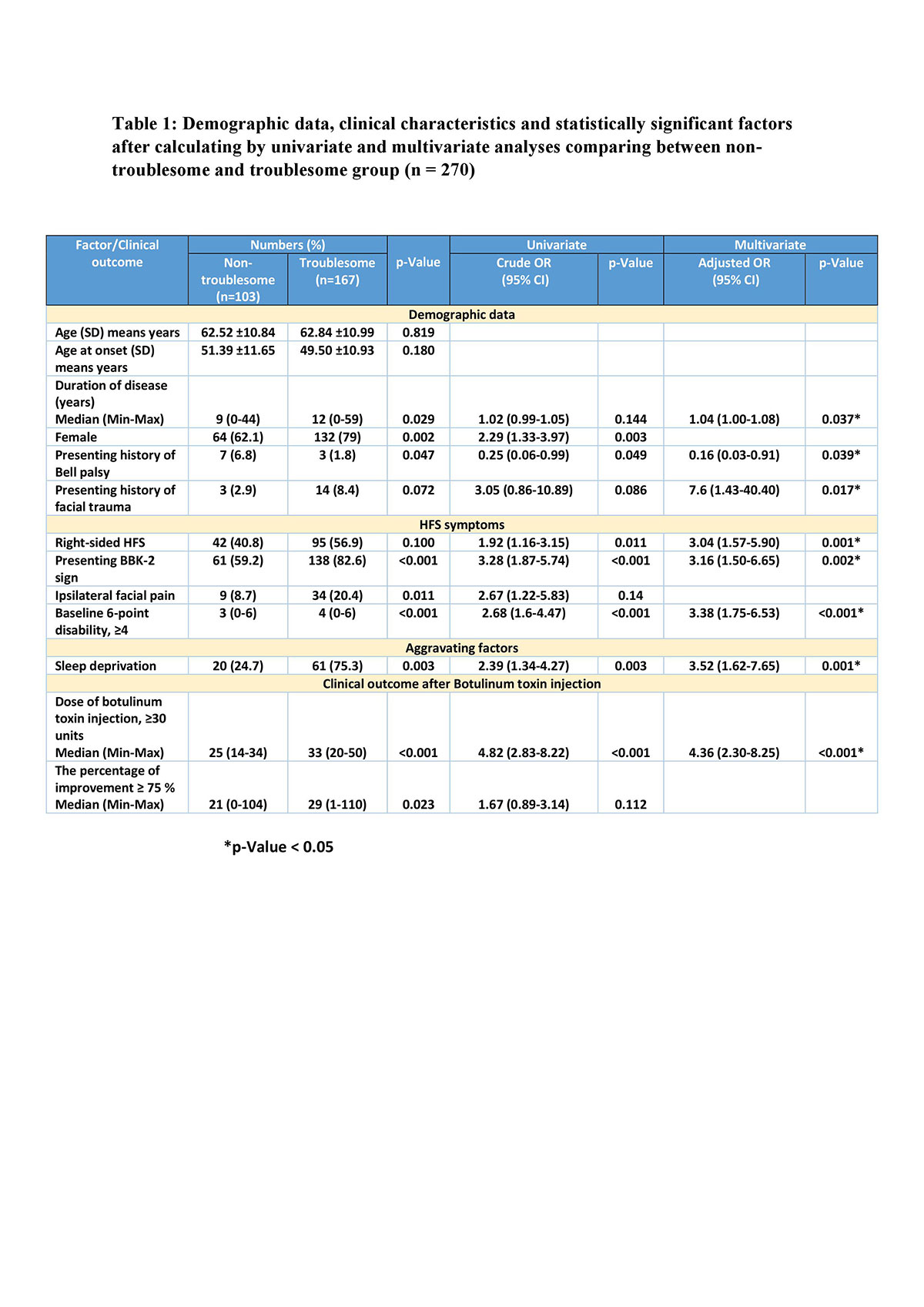Session Information
Date: Monday, September 23, 2019
Session Title: Myoclonus
Session Time: 1:45pm-3:15pm
Location: Les Muses, Level 3
Objective: To compare the clinical characteristics and treatment outcomes after injecting Botulinum neurotoxin type A (BoNT-A) between non-troublesome and troublesome hemifacial spasm (HFS) in Thais.
Background: HFS can cause facial disfiguration and, sometimes, impairs vision. There has been rarely reported regarding the comparison of the clinical characteristics and treatment outcomes between non-troublesome and troublesome HFS.
Method: A prospective single-center cohort study was performed in HFS patients registered to BoNT clinic at Siriraj Hospital, Thailand from August 2017 to January 2019. Demographic data, HFS symptoms, the Babinski-2 (BBK-2) sign, relieving and aggravating factors, and disease severity using SMC grading scale were collected. Treatment outcomes were evaluated including self-reported improvement during peak onset using a visual analogue scale, time-to-onset of action, time-to-peak effect, duration of improvement, and the quality of life using a 6-point disability rating scale and adverse events. All patients were divided into 2 groups (non-troublesome (SMC grade I, II) and troublesome (SMC grade III, IV) group). Chi-square, T-test, and binary logistic regression were used to calculate the difference between the 2 groups. Multivariate analysis was built by including all potentially important variables (p<0.2) from univariate analysis.
Results: A total of consecutive 270 HFS were included. The prevalence of troublesome group was 61.85% (n=167). The multivariate analysis showed that a longer disease duration, a history of facial trauma, an absence of history of Bell’s palsy, the right-sided symptoms, a presentation of the BBK-2 sign, ipsilateral facial pain, baseline 6-point disability scale greater than 4, and a history of sleep deprivation were significantly associated with troublesome HFS. The treatment outcomes and adverse events did not show a significant difference between 2 groups except the BoNT-A doses were higher in troublesome HFS group [table 1].
Conclusion: According to the results of our study, we imply that the physicians should carefully look for these factors when treating HFS patients. They may guide the physicians to detect troublesome HFS patients. Correcting controllable factor and using the appropriate doses of BoNT-A can provide a satisfactory outcome.
References: [1] Batla A, Goyal C, Shukla G, Goyal V, Srivastava A, Behari M. Hemifacial spasm: clinical characteristics of 321 Indian patients. J Neurol. 2012;259(8):1561-5. [2] Lee JA, Jo KW, Kong DS, Park K. Using the new clinical grading scale for quantification of the severity of hemifacial spasm: correlations with a quality of life scale. Stereotact Funct Neurosurg. 2012;90(1):16-9. [3] Wang A, Jankovic J. Hemifacial spasm: clinical findings and treatment. Muscle Nerve 1998;21:1740–7.
To cite this abstract in AMA style:
T. Sangpeamsook, Y. Pitakpatapee, A. Suengtaworn, J. Srikajon, P. Srivanitchapoom. The comparison of the clinical characteristics and treatment outcomes between non-troublesome and troublesome hemifacial spasm in 270 Thai patients [abstract]. Mov Disord. 2019; 34 (suppl 2). https://www.mdsabstracts.org/abstract/the-comparison-of-the-clinical-characteristics-and-treatment-outcomes-between-non-troublesome-and-troublesome-hemifacial-spasm-in-270-thai-patients/. Accessed December 20, 2025.« Back to 2019 International Congress
MDS Abstracts - https://www.mdsabstracts.org/abstract/the-comparison-of-the-clinical-characteristics-and-treatment-outcomes-between-non-troublesome-and-troublesome-hemifacial-spasm-in-270-thai-patients/

